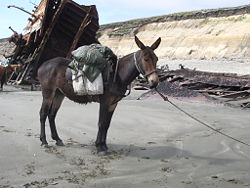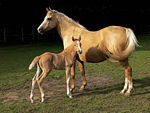Mule
| Mule | ||||||||||||||
|---|---|---|---|---|---|---|---|---|---|---|---|---|---|---|
 |
||||||||||||||
| Scientific classification | ||||||||||||||
|
||||||||||||||
| Binomial name | ||||||||||||||
| Equus mule? (Linnaeus, 1758) |
- For other uses, see Mule (disambiguation)
In its common modern meaning, a mule is the offspring of a male donkey and a female horse, which is classified as a kind of F1 hybrid. The much rarer offspring of a male horse and a female donkey is called a hinny. The term "mule" (Latin mulus) was formerly applied to the infertile offspring of any two creatures of different species. The mule, easier to breed [1] and usually larger in size than a hinny, has monopolized the attention of breeders . The chromosome match-up more often occurs when a donkey is the sire and the horse is the dam. Sometimes people let a stallion (male horse) run with a jenny (female donkey) for as long as six years before she becomes pregnant. Mules and hinnies are almost always sterile (see fertile mules below for rare cases). The sterility is attributed to the differing number of chromosomes of the two species: donkeys have 62 chromosomes, whereas horses have 64.
A female mule that has estrus cycles and can carry a fetus is called a "molly" and can occasionally occur naturally as well as through embryo transfer.
Contents |
Biology
Size
The median weight range for a mule is between 800 and 1,000 pounds (363 and 454 kg).[2]
Characteristics

With its short thick head, long ears, thin limbs, small narrow hooves, short mane, absence of chestnuts (horny growths) inside the hocks, the mule looks like a donkey; in height and body, shape of neck and croup, uniformity of coat, and teeth, it appears horse-like; the mule comes in all sizes, shapes and conformities. There are mules that resemble quarter horses, huge draft mules, fine-boned racing mules, shaggy pony mules and many more types.
A mule does not sound exactly like a donkey or a horse. Instead, a mule makes a sound that is similar to a donkey's but also has the whinnying characteristics of a horse (often starts with a whinny, ends in a hee-haw). Sometimes, mules whimper. The coats of mules come in the same varieties as those of horses. Common colors are Sorrel, Bay, Black, and Grey. Less common are White, Roans (both blue and red), Palomino, Dun, and Buckskin. Least common are Paint mules or Tobianos.
The mule possesses the sobriety, patience, endurance and sure-footedness of the donkey, and the vigour, strength and courage of the horse. Operators of working animals generally find mules preferable to horses: mules show less impatience under the pressure of heavy weights, and their skin, harder and less sensitive than that of horses, renders them more capable of resisting sun and rain. Their hooves are harder than horses', and they show a natural resistance to disease and insects. Many North American farmers with clay soil found mules superior as plow animals, especially in the U.S. state of Missouri, hence the expression "stubborn as a Missouri mule".
Mules are generally less tolerant towards dogs than horses are. They are also capable of striking out with any of their hooves in any direction, even sideways if needed.
Mules exhibit a higher cognitive intelligence than their parent species - horses and donkeys. This is believed to be the result of hybrid vigour, similar to how mules acquire greater height and endurance than either parents. [3]
Distribution
FAO reports that China was the top market for mules in 2003 closely followed by Mexico and many Central and South American nations.
Fertile mules
Several female mules have produced offspring when mated with a purebred horse or donkey. Since 1527 there have been more than 60 documented cases of foals born to female mules around the world. There are no recorded cases of fertile mule stallions. Mules and Hinnies have 63 chromosomes that are a mixture of one from each parent. The different structure and number usually prevents the chromosomes from pairing up properly and creating successful embryos. In most fertile mule mares, the mare passes on a complete set of her maternal genes (i.e., from her horse/pony mother) to the foal; a female mule bred to a horse will therefore produce a 100% horse foal. Some examples of recorded fertile mules include:
- Cornevin and Lesbre stated that in 1873 an Arab mule in Africa was bred to a stallion and produced female offspring. The parents and the offspring were sent to the Jardin d'Acclimatation in Paris. The mule produced a second female offspring sired by the same stallion and then two male offspring, one sired by a donkey and the other by a stallion. The female progeny were fertile, but their offspring were feeble and died at birth.
- Cossar Ewart recorded an Indian case in which a female mule gave birth to a male colt.
- The best documented fertile mule mare was "Krause" who produced two male offspring when bred back to her own sire (biological father).
- In the 1920s, "Old Beck", a mare mule at Texas A&M, produced a mule daughter called "Kit". When Old Beck was bred to a horse stallion she produced a horse son (i.e., the horse stallion sired horse foals). When bred to a donkey, she produced mule offspring.
- Likewise, a mare mule in Brazil has produced two 100% horse sons sired by a horse stallion.
- In Morocco, a mare mule produced a male foal that was 75% donkey and 25% horse, i.e., she passed on a mixture of genes instead of passing on her maternal chromosomes in the expected way.
- There is an unverified case of a mare mule that produced a mule daughter. The daughter was also fertile and produced a horse-like foal with some mule traits; this was dubbed a "hule". There are no reports as to whether the mule was fertile.
- A comparable case is that of a fertile hinny (donkey mother, horse sire - the reverse of a mule) in China. Her offspring, named "Dragon Foal", was sired by a donkey. Scientists expected a donkey foal if the mother had passed on her maternal chromosomes in the same way as a mule. However, Dragon Foal resembles a strange donkey with mule-like features. Her chromosomes and DNA tests confirm that she is a previously undocumented combination.
The modern mule


After World War II, mules fell on hard times. The use of mules for farming and transportation of agricultural products gave way to modern tractors and trucks. A dedicated number of mule breeders, however, continued the tradition as hobby and continued breeding the great lines of mammoth jacks started in the United States by George Washington with the gift from the King of Spain of two Catalan jacks. These hobby breeders began to utilize better mares for mule production until today's modern saddle mule emerged. Exhibition shows where mules pulled heavy loads have now been joined with mules competing in Western and English pleasure riding, as well as dressage and show jumping competition. There is now a cable TV show dedicated to the training of donkeys and mules. Mules, once snubbed at traditional horse shows, have been accepted for competition at the most exclusive horse shows in the world in all disciplines.
Amish farmers, who reject tractors and most other modern technology, commonly use teams of six or eight mules to pull plows, diskers, and other farm equipment, though they use horses for pulling buggies on the road.
During the Soviet war in Afghanistan, the United States used large numbers of mules to carry weapons and supplies over Afghanistan's rugged terrain to the mujahideen.[4]
The mule clone
In 2003, researchers at University of Idaho and Utah State University found a way to reproduce mules -- by cloning the first mule as part of Project Idaho. The research team includes Gordon Woods, UI professor of animal and veterinary science, Kenneth L. White, USU professor of animal science, and Dirk Vanderwall, UI assistant professor of animal and veterinary science. The baby mule, Idaho Gem, was born May 4. It is the first clone of a hybrid animal. Veterinary examinations of the foal and its surrogate mother showed them to be in good health soon after birth. The foal's DNA comes from a fetal cell culture first established in 1998 at the University of Idaho.
Color and size variety
Mules today come in a variety of shapes, sizes and colors, from minis under 50 pounds to maxis over 1000 pounds, and in many different colors. Mules from Appaloosa mares produce wildly colored mules, much like their Appaloosa horse relatives, but with even wilder skewed colors. The Appaloosa color is produced by a complex of genes known as the Leopard complex (Lp). Mares homozygous for the Lp gene bred to any color donkey will produce an Appaloosa colored mule.
See also
References
- ↑ "Love Longears - Longear Lingo". Retrieved on 21 November. "The equine hybrid is easier to obtain when the lower chromosome [c]ount (the donkey) is in the male. Therefore breeding for hinnies is more hit-and-miss than breeding for mules."
- ↑ "Mule". The Encyclopaedia Britannica: A Dictionary of Arts, Sciences, and General XVII. (1888). Henry G. Allen and Company. 15. Retrieved on 2007-12-26.
- ↑ Proops, Leanne; Faith Burden, Britta Osthaus (2008 -07-18). "Mule cognition: a case of hybrid vigour?" (PDF). Animal Cognition. doi:10.1007/s10071-008-0172-1. http://www.springerlink.com/content/c7r42628738ll2h8/fulltext.pdf. Retrieved on 2008-08-10.
- ↑ Bearden, Milt (2003) The Main Enemy, The Inside story of the CIA's Final showdown with the KGB
- This article incorporates text from the Encyclopædia Britannica Eleventh Edition, a publication now in the public domain.
External links
- British Mule Society
- A case of a mule giving birth
- LongearsMall.com - Online Donkey & Mule Community and Resource Directory
- Supply Mules in Kashmir
- John Henry - One of the world's nicest mules
- Project Idaho
- The American Donkey and Mule Society, registers mules of all types/educational information. Also some fertile mule information in FAQ.
- Mule Production (pub.1948) hosted by the UNT Government Documents Department
|
||||||||||||||||||||
